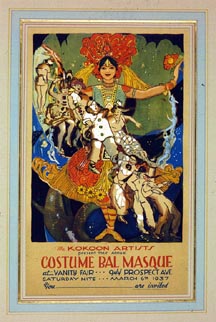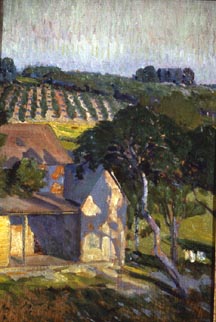 |
 |
 |
 |
 |
 |
 |
1911-1920 |
||||||
1911-1920
William Sommer (b. 1867 d. 1949) |
1911 -Kokoon Art Club established by Sommer, Moellmann, and other commercial lithographers. The club holds its first exhibition in November and remains active until 1956. -Mural by Kenyon Cox installed at the Charles Federal Building. -Walker and Weeks founded; foremost architectural firm of the 1920’s. -Frank Meade, architect for majority of residences of Cleveland industrialists and professionals for over 30 years. Died in 1947.
-Women’s Art Club established with more than 25 members; it institutes annual competitions and lectures and stays active until the 1950’s. -Charles Burchfield (died in 1967) enters the Cleveland School of Art to learn commercial illustration; studies with Gottwald but dislikes conventional studio classes and gravitates toward Eastman, Keller and faculty members in applied art and design. -Zorach, having recently returned from Europe, exhibits with “secessionists.” Visitors are bewildered by his pure, primary colors. -Biehle returns from Munich. In September he exhibits modernist paintings influenced by the German Blue River group at Rorimer-Brooks Studios. -R. Guy Cowan and Mildred Watkins exhibit ceramics at Taylor Gallery. Gage leaves managerial position at Taylor Gallery to establish Gage Gallery. -August Biehle Jr., was lithographer for Otis Lithography Corporation. He went on to become landscape artist, abstract painter and participated in the May Show for 25 years. He died in 1979.
-A year of great excitement, upheaval, and controversy in Cleveland art. Open conflicts arise between modernists and conservative painters. -Keller and MacCleod publish “The Gallery and Application of the Physiology of Color Vision in Modern Art.” -Cleveland Museum of Art incorporated; construction soon begins. -Gage Gallery opens, exhibits American impressionist paintings borrowed from MacBeth Galleries in New York. -Eastman and Wilcox join the faculty of the Cleveland School of Art as instructors of design. -Keller exhibits works in the Armory Show and delivers five public lectures about modern art at Potter Studio. -Cleveland Society of Artists founded as conservation rival to the Kokoon Klub by Adomeit, Coltman, Gottwald, William Edmondson, and others. The society aspires to continue traditions of academic art and craftsmanship. After 1918 modernists will join, including Biehle, Eastman, Keller and Wilcox. -An exhibition of ten French cubist paintings at Taylor Gallery. Keller writes the catalogue essay. Cleveland Plain Dealer ridicules this exhibition of “freak” art, while Leader is sympathetic. 1914 -Sommer converts a schoolhouse in Brandywine into a studio. -Exhibition of Amercian cubists and post-impressionists opens at Taylor. Includes paintings by Sommer, Warshawsky, Wilcox, Zorach, Marsden, Hartley and Max Weber. Gottwald denounces the new art as “all rot”. -August: World War I begins.
-Playhouse Settlement, from which Karamu House evolves founded as a social settlement but soon expands to include an arts center. -Cleveland Art Association established to promote local artists by purchasing their works and donating them to the museum, offering scholarships to the art school, sponsoring lectures, and organizing exhibitions. -Sommer and Zorach exhibit paintings at Kokoon Klub “Nut Futuriste”, includes works from“blasts” (Eastman,Keller, Wilcox, and Walter Heller)read an artistic manifesto accompanied by futurist songs and bizaare “noise”. -Society of Cleveland Artists holds an exhibition at Korner & Wood Galleries that includes paintings by Adomeit, Coltman, Edmondson and Gottwald. -Max Kalish returns from working on Panama-Pacific Exposition in San Francisco. Died in 1945. -Kokoon Klub hangs selection of paintings by Sommer and Zorach. -Burchfield wins third prize in the promotional poster competition for the Cleveland Museum of Art’s inaugural exhibition, scheduled for the following spring. -Karamu House established Gallery with special interest in works of talented black artists.
-Cleveland Playhouse (or “Little Theater”) established as an experimental workshop collaborative productions by artists, poets, dancers, and musicians. Raymond O’Neal elected first director. -Cleveland Museum of Art opens to the public with a large loan exhibition that includes works from Cleveland private collections as well as Chinese scroll paintings from the Freer collection. -Burchfield graduates, has his -J. Milton Dyer, designed Cleveland City Hall, active 1900-1920. Died in 1951. -Hessler Road completed, only remaining -Richard Laukhuff’s bookshop opened; supported and employed works by Sommer, Zorach and Burchfield. 1917 -Henry Turner Bailey, Dean of Education at the Cleveland School of Art, urges artists to find beauty in their city and champions the notion that art should aid industry. 1918 -Exhibition of modernist paintings opens at the Play House, including work by Burchfield, Deike, Keller, Sommer, Wilcox, and Zorach. -Cleveland Museum of Art makes its -John Huntington Polytechnic Institute of Art, opened as a tuition free night school, teaching many disciplines including architecture, painting and industrial design.
-May Show opened at the Cleveland Museum of Art. Closed in 1993. -Frederic Whiting urges artists to paint the city and find beauty in its factories. - William Milliken, curator of decorative arts, placed in charge of the May Show; newspapers praise the exhibition, which features the “sane” modernism of Keller and Wilcox. Whiting died in 1959. 1920 -William Grauer, trained in Philadelphia, settles in Akron. Died in 1985. -Cleveland Print Club established.
|
|
Overgrown Hermitage Along road to Zoar August Biehle (b 1885 d 1979) |
|
Mustard Jar, Cowan Pottery |
|
The William Lee Farm, Berlin Heights Henry Keller (b.1869-d. 1949) |
|
Brecksville Stage Coach Inn, Frank Wilcox (b.1887-d.1964 ) |
|




